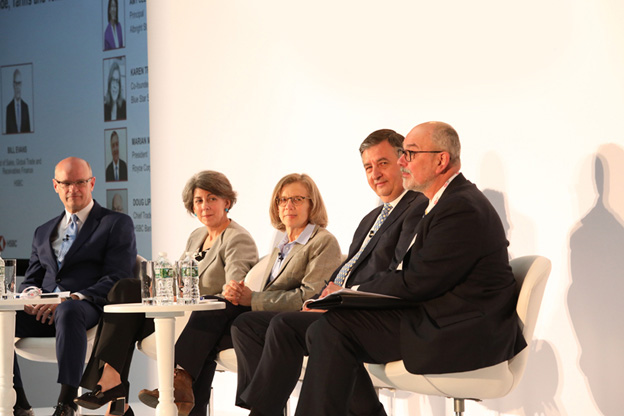- Article

- Support
- Market Research
Trade, tariffs and tensions
Where will current uncertainty lead?
The global trade environment is changing, says Doug Lippoldt, Chief Trade Economist at HSBC. “We had a round of rate increases last year, not just in advanced economies but emerging markets as well.” This pressure, he says, is starting to weigh on the global economy, and growth dropped from 2.9% last year to 2.1% this year.
Added into the mix are increased trade tensions and ongoing global uncertainty. In 2018, the US introduced several tariffs on imports – particularly those coming from China. Not long afterwards, China struck back with their own set of tariffs and, according to Peterson Institute research, an estimated 15% of US companies have been impacted in some way.
“We’re still not quite sure what will happen with Brexit,” says Lippoldt. It’s also unclear when the renegotiated North American Free Trade Agreement (NAFTA) – now known as the United States-Mexico-Canada Agreement (USMCA) – will be ratified. These factors are adding to the turbulence we’re seeing in the global trade landscape.
But despite recent tensions, the question remains: Is today’s trade climate really all that different than it has been in the past? And, more importantly, what can companies do to protect themselves as trade policies around the world continue to evolve? Here’s what leading industry experts had to say during a panel discussion at our event, The State of Global Trade 2019.
Trade tensions – what’s new (and what’s not)
“All US presidential administrations have trade tensions,” says Karen Tramontano, Co-founder and CEO of Blue Star Strategies, LLC. “There’s always some tension, but there’s never been this level of noise around it.”
China’s actions are a key differentiator in the current trade climate, adds Amy Celico, Principal at Albright Stonebridge Group. Tramontano agrees. “China is taking a more assertive position in redefining what compliance to trade rules looks like, including those rules that all the members of the World Trade Organization (WTO) agreed to follow.”
Uncertainty paves the way for openness in the East
According to published research, HSBC’s macroeconomics team projects that 70% of future world growth by 2030 will be in emerging market economies, with China expected to become the largest economy in the world.
That’s not surprising, says Lippoldt, when you compare contentious trade policy development and growing protectionism in the West with what’s happening across Asia Pacific. “While protectionism is increasing in certain markets like the US and the UK, many Asia Pacific countries are trying to liberalize to take advantage of changing trade patterns,” he says. “Openness is going to be very important for mature developed economies to be able to tap into the dynamism emerging markets represent.”
The Comprehensive and Progressive Agreement for Trans-Pacific Partnership (CPTPP), formerly TPP, is an example. So far, 11 countries have entered into the agreement, which will reduce tariffs and make trade easier between participants. “The initiative is still open to new members and could be extended to include countries such as Thailand, Colombia and possibly even the post-Brexit UK,” says Lippoldt.
What can corporates do to mitigate uncertainty?
Royce Corporation is just one company impacted by current US-China trade tensions. According to Marian Moscu, the company’s president, China makes up at least one-third of Royce Corporation’s business.
“It was no surprise that China retaliated to the US’ tariffs [on August 15, 2018],” he says. “The surprise was the speed in which they moved.” The tariffs went into effect just ten days later, on August 25. Royce had several shipments in transit to China at the time. “We had hundreds of containers on the water, when our clients started calling us telling us they wouldn’t be able to take delivery,” Moscu explains. “Luckily we were able to react quickly and divert shipments to other ports in South Korea, Japan, Taiwan and India.”
His advice for international companies looking to minimize risk exposure from sudden changes in trade policy is two-fold. First, he suggests that corporates diversify. “The more diversified you are, the easier it will be for you to have the flexibility to make adjustments.” You also need to be present, he says. “You need to listen to your clients and you need to be politically aware of what’s happening at home, as well as all the places you do business, to be fully prepared.”
Tariffs and tensions – what’s ahead?
While experts generally agree that tariffs rarely lead to long-lasting agreements that will relieve underlying tensions, they can sometimes be a path toward open dialogue.
Celico points out that the Chinese government is now talking about issues in the bilateral agreement that weren’t acknowledged as recently as a year ago – such as market access constraints and forced technology transfer requirements. And though challenges and further negotiations remain, these discussions are, at least, a step forward.
HSBC Bank USA, N.A. makes no representations whatsoever regarding content of the material shared. It is being shared by HSBC Bank USA, N.A. for information purposes only without review or validation of the content. This document is intended for discussion and does not create any contractual commitment on the part of HSBC Bank USA, N.A.



